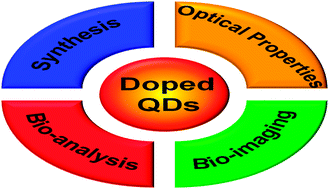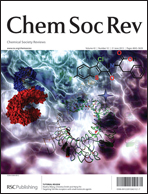Doped quantum dots for chemo/biosensing and bioimaging
Abstract
Quantum dots (QDs) have received great interest for diverse applications due to their distinct advantages, such as narrow and symmetric emission with tunable colors, broad and strong absorption, reasonable stability, and solution processibility. Doped QDs not only potentially retain almost all of the above advantages, but also avoid the self-quenching problem due to their substantial ensemble Stokes shift. Two obvious advantages of doped QDs, especially doped ZnS QDs, over typical CdSe@ZnS and CdTe QDs are longer dopant emission lifetime and potentially lower cytotoxicity. The lifetime of dopant emission from transition-metal ion or lanthanide ion-doped QDs is generally longer than that of the bandgap or defect-related emission of host, and that of biological background fluorescence, providing great opportunities to eliminate background fluorescence for biosensing and bioimaging. For bioimaging applications, fluorescent dopants may mitigate toxicity problems by producing visible or infrared emission in nanocrystals made from less-harmful elements than those currently used. In this review, recent advances in utilizing doped QDs for chemo/biosensing and bioimaging are discussed, and the synthetic routes and optical properties of doped QDs that make them excellent probes for various strategies in chemo/biosensing and bioimaging are highlighted. Moreover, perspectives on future exploration of doped QDs for chemo/biosensing and bioimaging are also given.


 Please wait while we load your content...
Please wait while we load your content...